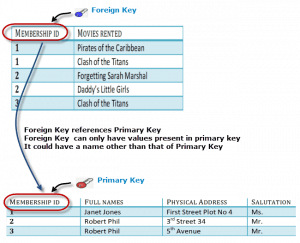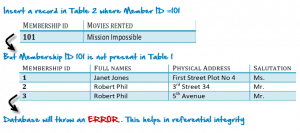Database normalization design method that lowers information redundancy and eliminates unfavorable attributes like Insertion, Update, and Removal Abnormalities. Normalization rules divide more oversized tables into smaller tables and link them using relationships. Normalization in SQL is to remove redundant (recurring) data and make sure data is stored realistically.
What Is 1NF, 2NF, 3NF, BCNF In Database Normalization?
In this article, you can know about database normalization here are the details below;
The developer of the relational model, Edgar Codd, proposed the theory of database normalization with the intro of the First Regular Type, and he continued to extend the idea with the 2nd and Third Regular Type. Later on, he joined Raymond F. Boyce to establish the theory of Boyce-Codd Regular Form.
Database Normal Forms
Here is a list of Regular Types
- – 1NF (First Regular Kind).
- – 2NF (Second Typical Form).
- – 3NF (Third Typical Kind).
- – BCNF (Boyce-Codd Regular Type).
- – 4NF (4th Regular Kind).
- – 5NF (5th Normal Form).
- – 6NF (Sixth Regular Kind).
The Theory of Database Normalization in SQL is still being established even more. For example, there are conversations even on the sixth Regular Form. Nevertheless, in most useful applications, normalization achieves its finest in the 3rd Regular Type. The development of Normalization theories is illustrated listed below-.
Database Normalization with the Examples.

Database Normalization Examples can be easily understood with the help of a case study. Assume a video library keeps a database of movies rented. With no database normalization, all information is kept in one table, as revealed below.
Here you see Films Rented column has numerous worths. Now let’s move into 1st Typical Kinds.
- 1NF (First Regular Form) Rules.
- – Each table cell must include a single value.
- – Each record requires to be distinct.
- The above table in 1NF-.
- 1NF Example.

Before we proceed, let’s understand a couple of things–.
What is a Key ?
A KEY is a worth used to recognize a record in a table uniquely. A KEY could be a single column or mix of several columns.
Keep in mind: Columns in a table that are NOT used to determine a record uniquely are called non-key columns.
What is the Main Key?
A main is a single column worth utilized to identify a database record uniquely.
It has the following characteristics.
- – A primary key cannot be NULL.
- – A primary essential worth needs to be remarkable.
- – The primary key worths need to rarely be changed.
- – The primary key should be given a worth when a new record is inserted.
What is a Composite Key?

A composite key is the primary key composed of numerous columns utilized to identify a record uniquely. Our database has two individuals with the same name Robert Phil, but they live in different places.
Thus, we require both Full Name and Address to determine a record distinctively. That is a composite key.
Let’s move into the second standard form, 2NF.
2NF (Second Typical Type) Guidelines.
- – Rule 1- Be in 1NF.
- – Rule 2- Single Column Main key.


We can’t make our simple database in the second database normalization type unless we partition the tables above. We have divided our 1NF tables into two tables viz—table 1 and Table2. Table 1 consists of member details. Table 2 includes details on movies rented.
We have introduced a brand-new column called Membership_id, which is the primary key for table 1. Records can be uniquely determined in Table 1 using subscription id.
Database Foreign Key.

In Table two, Membership_ID is the Foreign key.
- Foreign key recommendations the primary key of another Table! It assists in connecting your Records.
- A foreign key can have a separate name from its primary key.
- It guarantees rows in one table have matching rows in another.
- Unlike the Main key, they do not have to be unique. Usually, they aren’t.
- Foreign keys can be null, although primary key cannot.

Why do you require a foreign Key ?

Expect a beginner inserts a record in Table B such as. You will just have the ability to insert worth’s into your foreign key in the distinct key in the mom and dad table. This helps in referential stability.
The above problem can be conquered by stating membership id from Table2 as a foreign key of membership id from Table1. Now, if someone attempts to insert a value in the membership id field that does not exist in the mom and dad table, an error will be shown!
What are transitive practical reliance’s?
A transitive functional reliance is when altering a non-key column might cause any other non-key columns to change. Think about the table 1. Changing the non-key column Complete Name might change Salutation.

Let’s move into 3NF.
3NF (3rd Regular Type) Rules.
- – Guideline 1- Remain In 2NF.
- – Rule 2- Has no transitive practical reliances.
To move our 2NF board into 3NF, we once again need to once again divide our table. We have once again divided our tables and developed a new table which stores Salutations.
There are no transitive practical reliances, and hence our table is in 3NF. In Table 3, Salutation ID is the main key, and in Table 1, Salutation ID is foreign to the primary type in Table 3.
Our little model is at a level that cannot, even more, be broken down to attain higher typical forms of normalization. It is already in more significant normalization kinds. Different efforts for moving into the next levels of stabilizing information are usually needed in complex databases. Nevertheless, we will be going over the following groups of database normalization in brief in the following.
BCNF (Boyce-Codd Regular Kind).
Even when a database remains in 3rd Typical Type, there would still be abnormalities resulting from more than one Prospect key.
Sometimes is BCNF is likewise referred to as 3.5 Regular Kind.
4NF (4th Regular Kind) Guidelines.
If no database table circumstances contain two or more independent and multivalued data explaining the relevant entity, it remains in the fourth Typical Type.
5NF (Fifth Typical Kind) Guidelines.
A table remains in fifth Normal Form only if it remains in 4NF, and it cannot be decayed into any variety of smaller sized tables without loss of information.
6NF (Sixth Regular Type) Proposed.
6th Normal Kind is not standardized. However, it is being discussed by database professionals for a long time. Ideally, we would have a clear & standardized definition for the 6th Typical Form in the future…
Conclsuion:
Database designing is vital to the successful implementation of a database management system that satisfies a business system’s data requirements.
- – Normalization in DBMS assists produce database systems that are cost-efficient and have better security models.
- – Practical dependences are a really essential part of the normalized data process.
- – A lot of database systems are normalized databases up to the third typical types.
- – A primary essential uniquely determines are record in a Table and cannot be null.
- – A foreign key assists connect table and referrals, a primary key.



